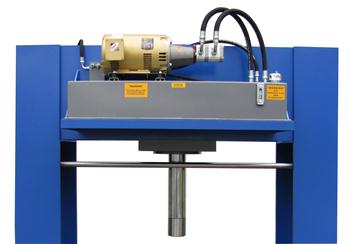There are many ways to manipulate and transform metal, roll forming and stamping are some techniques that come to mind, but when it comes to bending metal, nothing beats a
hydraulic press.
Hydraulic presses are more common than you think. Virtually every machine shop has one on their floor and they are used to form and manipulate metal used to create everything from the most delicate piece of jewellery to the sturdiest of cars. But what are the steps that need to be taken before the machining process can begin, what must be calculated so that everything goes smoothly and no steps need to be repeated twice?
Ultimate tensile strength (UTS):
Ultimate tensile strength (UTS) which is sometimes known only as tensile strength (TS) is the maximum amount of tensile (stretching) force than can be applied to any type of material before it reaches its breaking point. The opposite of tensile strength is known as compressive strength.
Force per unit of the material:
The equation that results in obtaining the tensile strength of metal is calculated by dividing the area that is being stretched or pressed (also known as the cross section), by the stress that is being placed on the material. This process is known as the force per unit area. The unit that is used to calculate the results are pounds of force per square inch (lb f / in2, or psi) or kilo-pounds per square inch (ksi) which is the equivalent of 100 psi. The generic unit of measurement used is ksi.
It’s important to know the tensile strength of the material that is being shaped in the press because it will give the operator an idea of what applications the material can perform and what are those that it cannot.
Compressive versus tensile strength:
Compared to other materials that can be shaped by a hydraulic press, steel has an important tensile strength. In fact, the tensile strength of steel is nearly identical to its compressive strength. This means that steel is able to withstand an equal amount of crushing and stretching before it reaches its breaking point. Compared to that, another material, like concrete for example, has a high compressive strength but a low tensile strength.
Knowing the material to be transformed:
Whatever the material that is to be transformed in a hydraulic press, it’s important to know its tensile strength before any operation can begin. Heat tolerance, hardness, corrosion resistance and the ability to be welded or not are factors that also must be taken into consideration.
Bending different materials:
When a piece of metal is being bent, the hydraulic press curves and bends the metal using its flexibility to modify its original shape. The metal or steel is transformed past its yield strength but without surpassing its crucial tensile strength. If that equation isn’t respected, the metal breaks. When a piece of metal is being manipulated with the use of a hydraulic press, the bending process produces very minimal or no variation of thickness in the sheet metal.
Pressmaster is a North American
hydraulic press manufacturer. The multiple features of their presses are standard and guaranteed to be operator friendly. For more information on Pressmaster,
contact us today.

